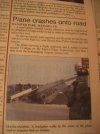-
Please take a moment and update your account profile. If you have an updated account profile with basic information on why you are on Air Warriors it will help other people respond to your posts. How do you update your profile you ask?
Go here:
Edit Account Details and Profile
You are using an out of date browser. It may not display this or other websites correctly.
You should upgrade or use an alternative browser.
You should upgrade or use an alternative browser.
Piper Crash
- Thread starter vanity
- Start date
Whalebite said:Glad you and your instructor are ok.
Is it true that one out of every 5 miles of interstate is supposed to be flat, straight, and unobstructed, to be used in an emergency in wartime?
Yeah...no. (Anyone who has driven on H-3 can attest to that! Also, when has I-95 between Virginia and Maine ever not been obstructed?
 )
)http://www.snopes.com/autos/law/airstrip.asp
Whalebite said:Glad you and your instructor are ok.
Is it true that one out of every 5 miles of interstate is supposed to be flat, straight, and unobstructed, to be used in an emergency in wartime?
In the US...no...in North Korea....yes.
Generally each series of engines on a series of aircraft has a TBO, or time before overhaul. Generally, that's 2000 hours. So if this plain was 2500 past due, I'm assuming that means 500 over. Eitherway, it's illegal, and worthy of a violation of the PIC. There are some other reqs, like for commercial operations (I think it is), you need a 100 hour inspection, plus there's the annual, which happens every, you guessed it, year.
If an engine makes metal, it means it's causing shavings in the crank case (or transmission for turbo-x engines).
If an engine makes metal, it means it's causing shavings in the crank case (or transmission for turbo-x engines).
My family used to own a cessna and at one of the annuals, it had a unsual amount of metal collected. The oil filter is checked at every oil change for these metal pieces and most filiters will have some. It is all based on how much and how big the pieces are. There is also another filter to collect bigger pieces that is just a metal 'basket' used as a last resort.
After they saw the unusal amount of metal in the filter, they took apart one cylinder and found the heads to be torn up really bad. Since the heads were torn up, the crankshaft was torn up.
It was a bad day to own a airplane (needed new/overhauled engine). The mechanics were amazed the engine hadnt siezed already.
It was about 200 hours from TBO
I edited this to take out the information vanity deleted pending the FAA investigation. - HAL Pilot
After they saw the unusal amount of metal in the filter, they took apart one cylinder and found the heads to be torn up really bad. Since the heads were torn up, the crankshaft was torn up.
It was a bad day to own a airplane (needed new/overhauled engine). The mechanics were amazed the engine hadnt siezed already.
It was about 200 hours from TBO
I edited this to take out the information vanity deleted pending the FAA investigation. - HAL Pilot
mules83 said:It was about 200 hours from TBO
I guess that's better than 200 hours after a TBO.
gatordev said:Generally each series of engines on a series of aircraft has a TBO, or time before overhaul. Generally, that's 2000 hours. So if this plain was 2500 past due, I'm assuming that means 500 over. Eitherway, it's illegal, and worthy of a violation of the PIC. There are some other reqs, like for commercial operations (I think it is), you need a 100 hour inspection, plus there's the annual, which happens every, you guessed it, year.
If an engine makes metal, it means it's causing shavings in the crank case (or transmission for turbo-x engines).
http://www.avweb.com/news/columns/187037-1.html
I had this same type of situation in the DC-10. We took off out of Pago Pago for Honolulu with a full load of 305 Samoans. We were supposed to make our initial level off somewhere in the mid 20s. Around 17,000 we just couldn't climb any more. We were setting there scratching our heads trying to figure out why (all the engines looked good) - after all we'd all done this plenty of times with no problems. After a while it hit us. We were in a DC-10-10 and not a DC-10-30 which was normally used for the Samoa flights. Standard pax weights (at that time) were 175 lbs. The average Samoan weight was probably in the range of 250-300 lbs. We were way over weight. The DC-10-30 had a lot more powerful engines and this covered up the difference between standard and actual weights. We ran the numbers and figured out there was no way to make it at the lower altitudes so we dumped and went back to Pago Pago. Using actual weights, we had to kick off almost 40% of the passengers - and boy were they pi$$ed. Hawaiian sent a second plane the next day to get them and gave them big cash compensation which I'm sure they used to pack on a few more pounds. Hawaiian also had to do a weight survey and the Samoan standard weight was increased to around 250 lbs.Steve Wilkins said:I had the same problem....well ok, sort of....when I took off one day in Idaho. I was familiar with the airport and had flown out there many times before. HOWEVER, this particular time was in a 152 (trying to save the $$) and I was flying with my roomate's girlfriend. When I finally got airborne after a loooonnnnng takeoff roll, the plane refused to climb. I'm sitting there, like WTF? Check carb heat...yep, it's in....check the tach....hey, wait a minute, this engine sucks! I finally get up to pattern altitude about 2 miles past the runway threshold, turn back on downwind, base, final, land and taxi back to the ramp. I finally figured out a couple weeks later after thinking about it. The damn chick was too heavy! I wanted to strangle my roomate.
Dixon said:
Interesting, thanks for the link. Doesn't negate the fact that an annual or 100 hour still needs to be done.
gatordev said:Interesting, thanks for the link. Doesn't negate the fact that an annual or 100 hour still needs to be done.
Very true....
Vanity....from the pic i didnt see any fuel spilled. Did a wing hit the utility pole?



